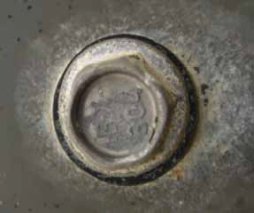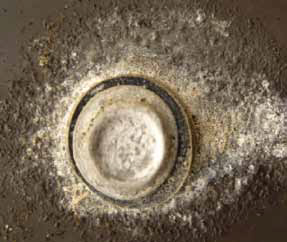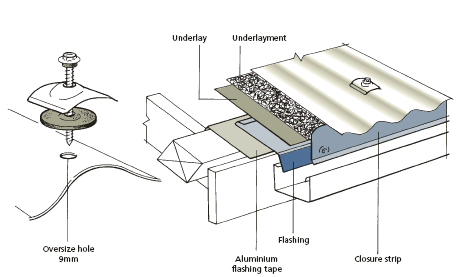Stainless Steel Fasteners
Stuart W.Thomson
Building Consultant
In the last year or so we have seen an increase in demand from BCAs for the use of stainless steel screws in Zincalume® roofs in severe environments.This is partly based on their interpretation of NZS 3604, which of course is for framing not cladding.
This is not acceptable for NZMRM roofs, so in this edited and abridged article Stuart Thomson explains why not, and discusses the technical reasoning behind the BCAs’ wish and our rebuttal. Worth noting is that new developments in both cladding material and fasteners may well render this issue a non-problem in the not-too-far-distant future.
Stuart Hayman:
MRM Technical Committee
When speaking with a disgruntled roofer recently he said ‘how is it that years ago we just used to nail on the wrinkly tin with some lead heads without all the fuss that we have to go through now?’ While one must have sympathy for this point of view, there are things that have changed - a lot of things.
For instance, after a roof was nailed on, the owner got up and painted it every few years which not only protected the galvanised metal but sealed the fastener to the roof cladding as well. Now, we do not use galvanised roof cladding any more, and the majority of steel roofs are made from pre-painted
Zincalume® and are expected by the general public to last forever without any maintenance. And then there are the new building Standards, the NZ Building Code and building controls.
There have been some instances recently where BCAs, with probably the best intention of protecting the durability of the building, have required the use of stainless steel fasteners when installing steel roof and wall cladding in a severe or very severe environment. NZMRM does not agree that this suggestion
will help the life of the roof and this article will explain why this is not a good solution.
There are a number of different corrosion issues here, which this article will attempt to clarify for designers and BCAs alike.
Firstly it is logical to consider the big picture and then deal with the specific ones. Corrosion as a problem is usually associated with metal, but perhaps the biggest corrosion issue ever for NZ to face has been the corrosion of timber. Leaky homes were mostly caused by designing and using the wrong material in the wrong place and metals are not immune from this problem either.
Rusting steel is a common symbol of deterioration although there are instances of iron or steel that has lasted for centuries. The 7m high iron Pillar of Delhi is over 1600 years old and its oxide has a soft look and feel of chocolate – I felt it before they put the fence around it. The cans of food found recently in Antarctica have survived over 100 years without rusting away although the missing labels would make their opening interesting! Antarctic’s 0.03% average humidity combined with the extreme cold make the South Pole region the world’s driest desert.
So what this tells us is that corrosion is very much the result of the environment. What may not be an issue with dissimilar metals in a mild rural environment can quickly become a disaster in a coastal one.
Every country is different and it is not surprising that the Plastisol coated COLORSTEEL® VP developed by British Steel that failed in New Zealand 30 years ago is still being sold in Europe.
The New Zealand Roof and Wall Cladding Code of Practice has been written for local conditions and recognises New Zealand as unique islands 2,000 km away from any other major land mass. New Zealand, being in the middle of large oceans, naturally has its coast exposed to high winds, UV and high salt aerosol. Everyone likes to live by the sea notwithstanding that this creates a very severe corrosion environment (C5).
For corrosion to occur there must be an electrolyte i.e. moisture, and it just so happens that salt is hygroscopic and therefore if it is not washed off the metal the contact remains wet. The more salt and the longer the time the contact remains wet, the worse the corrosion. All metals have different electrochemical potentials and the greater the difference of the potential between metals in contact, the worse the corrosion.
The subject of corrosion is covered comprehensively in section 2.4. of the COP.
New Zealand has been classified into corrosion categories or zones by various NZ Standards which have all used ISO 9223 and ISO 9224 as their basis. However each new NZ or AS/NZ Standards committee for one reason or another has modified these classifications to suit the prime purpose of the standard under review.
These have now been changed to the extent that there is conflict between not only the nomenclature used, but also the essence of the Standard classification. The metal manufacturers’ paint systems and metal fasteners are also classified for performance to ISO categories so it is little wonder that there is confusion because we have just about as many referees on the field as we have players.
The latest example appears in the revised and recently published NZS 3604:2011 but AS/NZS 3566 and AS/NZS 2728 are also recent examples. The classification of the ISO corrosivity of atmospheres is relatively simple - they are C1 to C5. These are determined by airborne salinity, the TOW (Time of Wetness) and RH (Relative Humidity) although there are a number of methods given to determine these. The decision by the Standards committee to introduce a ‘Sea Spray’ Zone into NZS 3604:1999, as well as turning the categorizing numbers inside out, was a bad move and opposed by the NZMRM at the time.
NZS 3604: 2011 reverses that decision and has now deleted the Sea Spray Zone - just when everyone was getting their head around it!. A new nomenclature borrowed from AS/ NZS 2728 has now been substituted which reclassifies C2-C5 into Category B to E. (In 3604 Category A, indoors has been omitted, and Category D and E have been combined, because they both use the same stainless fasteners).
This change could continue to create the occasional demands by BCAs to use stainless steel fasteners for roof cladding in the worst corrosion zone (now become D in 3604); without regard for metal compatibility. This confusion occurs because Table 4.1 of NZS 3604 2011 requires all structural fixings in Zone D in sheltered and exposed environments to be 304 stainless steel.
There are anomalies within 3604 and the NZBC E2 & B2 because if metal roof and wall cladding is considered easy to replace, the fastener legally need only last 15 years. But try telling this to an owner who has rusty fasteners after a few years e.g. Westpac Stadium.
There is a different reason for the NZS 3604 emphasis because it is primarily concerned about the integrity of timber structures and their connections. A stainless fastener is required to work in treated timber in these instances for a number of reasons. Firstly the head is in an exposed marine environment and secondly, the part of the fastener that is embedded in the timber is likely to suffer corrosion from the copper salts required to preserve exposed timber. Exposed timber also suffers from the corrosion of embedded steel fasteners which is known as ‘timber sickness’.
For this reason all fixings in contact with timber treated to H3.2 or higher or with Copper Azole, or Alkaline Copper Quaternary (ACQ) preservatives, and used in exposed or sheltered locations must be 304 stainless steel.
But wait there’s more - the timber treatment rules have just been changed by the DBH. What you should know now about timber treatment.
All framing timbers (with a few exceptions) are now required to be Radiata Pine treated to H1.2 or untreated Douglas Fir. Back to Boron (boric acid) treated (pink stuff). This preservative is much less aggressive to fasteners than copper based treatments, but beware there are other preservatives still being sold that are. The exceptions to the H1.2 rule include battens used behind cladding to form a cavity, which have to be H3.1.and this treatment can be either solvent-based or boron (H3.1 boron treatments supplied grey primer-painted). Another exception is any exposed roof framing rafters or purlins (verandas, canopies or eaves) which continue to require H3.2. treatment - using copper based preservatives.
This DBH change does help simplify use of timber on-site, and to some extent with the separation issue between timber and metal claddings and fasteners but doesn’t help when the external environment is to be considered. It could be said that the fasteners for metal roof cladding are in a similar situation to exposed framing timbers, but in addition, if the shank is exposed it would be in an unwashed environment (NZS 3604 calls it sheltered). Because the issue of compatibility is a major concern the manufacturers of Zincalume® (painted or plain) do not issue a warranty for any roof fastened with stainless steel fasteners.
Determining Corrosion zones is a complicated issue because contrary to some of the assumptions made, NZ does have a C5 Zone with about 50% of its coastline in a very severe marine environment. However to further complicate things the corrosion zones do overlap.
Metal roof and wall cladding is not constrained by NZS 3604 or E2/ AS1 and therefore does not have to comply as it becomes an Alternative Solution to the NZBC. Unfortunately some BCAs have taken the stance that roof and wall claddings may be structural and so need to comply with NZS 3604 (framing) and need to use stainless steel fasteners in severe marine environments
This creates a clash with metal roof cladding manufacturers and the NZMRM COP which follows the requirement of the suppliers of the raw material i.e. NZ Steel and P.C.C. who state that stainless steel fasteners must not be used with steel cladding or their warranty will be voided. So the designer or the roofer can be caught between a rock and a hard place. Maintaining the appearance and function of the screw may be at the cost of failure of both appearance and function of the cladding.
 It is not well-known that the Zincalume® metallic coating has very little zinc content and is mostly aluminium (80% by volume). What this means is that the sacrificial protection given to steel by the zinc in Zincalume® is much less than is the case with galvanised steel, and it is the relatively unprotected cut edge that causes haloing around the screw in severe environments.
It is not well-known that the Zincalume® metallic coating has very little zinc content and is mostly aluminium (80% by volume). What this means is that the sacrificial protection given to steel by the zinc in Zincalume® is much less than is the case with galvanised steel, and it is the relatively unprotected cut edge that causes haloing around the screw in severe environments.

The reason is that in severe or very severe environments corrosion will rapidly occur at the interface of these two dissimilar metals and lead to a breakdown of the paint and metallic coatings at these points. But while an AZ coating is excellent in well washed areas where it is protected, it must not remain wet
particularly when it is directly in contact with other metals and in specifically with stainless steel. The extra cost of stainless steel fasteners is not the issue. What is of greater concern is the inability or unwillingness of the fastener industry to provide a Class 5 fastener for a C5 corrosion zone. NZ is represented on the AS/NZS 3566.2 joint standards committee by Stuart Thomson and Alistair Fleming from NZ Steel and the draft now has NZ only clauses:
- the introduction of a class 5 fastener,
- the reintroduction of hot dipped galvanised fasteners
- the requirement to mark the corrosion class on the hexagon head of self- drilling screws.
The old HDG (hot dipped galvanised) coated screw has gone, - the result of the ‘green’ philosophy dominating the scene, hydrogen embrittlement and the fact that the point of self-drilling screws will not ‘drill’ if it has a lot of zinc on it. At the present time, fasteners for steel roof and wall cladding are
mechanically plated with a zinc and tin powder mixture and a class four (C4) is the best available. Hopefully this will change for New Zealand when AS/NZS 3566.2 is finally published.
But wait there’s more! - For a C4 fastener to comply with AS/NZS 3566.2 it only has to last for 10 years whereas the NZBC requires metal cladding to last for a minimum of 15. The answer may be to coat the zinc plated fastener with a more exotic organic coating or to replace fasteners during the lifetime of the
cladding.
However there is yet another anomaly. Although the AS/NZS 3566.2 performance test only requires <5% red rust over 10 years exposure as a pass, the fastener manufacturers do not warranty their fastener in that manner. Their warranty only covers ‘integrity’ not aesthetics which is what B2 NZBC also requires. So your roof may not blow off but it might look pretty rusty and yet still comply with the NZBC.
There is an alternative fastener that can be used for fixing metal roof and wall cladding if the framing is timber and that is an aluminium screw fastener. While this is not suitable for fixing into steel it is compatible with AZ coatings, but just watch though that the purlins or battens are not copper treated with Copper Azole, or ACQ.
For some time now the NZMRM have been investigating and testing isolation techniques for use with aluminium and metallic coated steel cladding and stainless steel fasteners in severe and very severe marine environments. Some of these are to be published in the Code of Practice as shown in the drawings above.

Stainless steel fasteners manufacturers have recently introduced inorganic and organic surface coatings. They come with trade names such as Climaseal, Armourcoat, Rustpert, Xylan, Tufcoat, EP5 and others and these coatings provide a degree of isolation between dissimilar metals. A better bet is to
also isolate the fastener and metal cladding physically by the use of oversized holes.
The most commonly specified stainless steel alloys are 304 and 316. 304 is generically referred to as 18-8 which indicates a group of stainless steels having nominally 18% chromium and 8% nickel content. The 18-8 family includes alloys; 302, 302HQ, 303, 303Se, 304 and 304L. 316 is not an 18-8, but is generally accepted as an 18-8 substitute since it has improved corrosion resistance over the 18-8 family. Sometimes 304 stainless screws are marked A2 on the head while 316 are marked A4.
316 fasteners for roof cladding are not recommended at all because they have a higher electro-potential than 304, and so will cause even greater corrosion.
Conclusion
At the present time only galvanised (i.e. with some form of zinc coating) screws should be used with AZ metallic coated steel claddings in severe and very severe marine environments.
